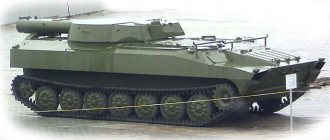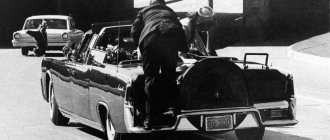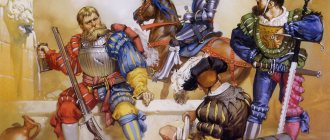Barbarians - you still don’t know the context in which this word is spoken, but you are already imagining something bad. The people who bore this “title” were in fact not at all like bloodthirsty killers and uneducated savages. Everything was exactly the opposite.
In general, the ancient Romans and Greeks called “barbarians” not a specific group, but all foreigners: from the Goths and Vikings to the eastern tribes from Asia and the Slavs. Popular history has somehow distorted the image of these warriors, turning them into hardened criminals. It's time to figure out where the lies are and where the truth is.
The barbarians were famous for their relative nobility
Another prejudice about barbarians - they were cruel, raped women, burned settlements - in general, they destroyed everything they saw on the way. In fact, they did not differ in this way, compared to the same “civilized” Greeks and Romans. In 455, the barbarians conquered Rome - and, more unusually, did not commit any atrocities or robberies.
Women in barbarian circles had special rights
In other empires, a woman had almost no rights, and many were even treated as a thing. In barbarian cultures, things were different: women could own property, inherit it, own a business, and even vote. And the fair sex fought equally with men.
The collapse of Alaric's plans
Next, Alaric’s army advanced to the grain-rich regions of the Roman Empire. These were Campania and Sicily, but the main target was the province of Africa - the main breadbasket that fed the entire empire. However, this plan was not destined to come true; Alaric died at the age of 34 in the town of Consentia.
He was buried in a deep hole that was dug in the Buzent riverbed. Its waters were diverted into a new channel. Countless priceless treasures were buried with the leader. After the grave was buried, the river was allowed to follow its previous course. Then all the slaves who were engaged in these works were killed so that no one would know about the secret of the buried treasures and Alaric.
The warriors were distinguished by a special martial art
The barbarians mastered the subtle art of combat, worse than the Romans and Greeks. Basically, the Celts and Germans took tactics rather than simply force. They did not attack their neighbors without reason, they fought only to protect their territory from invaders (with exceptions, of course). Even more high-tech armies feared barbarian fighters.
Literature
- Alphand, Louis.
Great barbarian empires: from the Great Migration of Peoples to the Turkic conquests of the 11th century. - M.: Veche, 2006. - Shchukin M. B.
At the turn of the era. - St. Petersburg, 1994. - Makarevich V. M., Sokolova I. I.
Encyclopedia of world history. - Bustard, 2003. - ISBN 5710774316. - Musset, Lucien.
Barbarian invasions of Western Europe. - St. Petersburg, 2006. - Ancient Europe. Encyclopedia of the Barbarian World. Vol. 1-2. / Bogucki, Peter (ed.).
Barbarians knew about hygiene, unlike Europeans
Barbarians were often called “dirty,” but not because of a lack of love for hygiene, but rather because of their internal qualities. In terms of body cleanliness, on the contrary, they were particularly neat: they took care of themselves, took a shower, and looked after their health. In general, they did everything that the Europeans refused. By the way, during the Crusades, residents of the east who took care of themselves were also called “barbarians.”
The barbarians not only destroyed, but also created
Not all barbarians lead the lifestyle of nomads. Yes, we often had to move from one place to another due to weather or hunting. However, many “barbarian” peoples preferred to settle in one point and create modern cities and settlements at that time, which were in many ways better than Roman and Greek ones.
The barbarians had a diplomatic approach
In popular culture, barbarians are portrayed as thoughtless and cruel. The truth is a little different: most of the representatives of this people preferred to seek a compromise and negotiate peacefully, even with enemies. Instead of destroying the Indian tribes, they entered into cooperation agreements with them - the war seemed to everyone a destructive last resort. The colonialists abandoned this approach, so most of the indigenous population was simply killed or tortured.
The barbarians looked more than neat
The Germanic tribes, which the Romans and Greeks recognized as barbarians, were not at all like the heroes of “Game of Thrones” - no rough skins in the north and unkempt rags in the south. The barbarians were the first to wear trousers, which certainly turned out to be a reason for ridicule among the “civilized” population, who had been sporting skirts for a long time.
Where do they meet?[edit]
(link)
Barbarians
General[edit]
- In fantasy, this role is usually played by orcs, goblins, ogres, trolls and various bestial humanoids.
Literature[edit]
- Arda - three tribes of the Edain, and all other people of the First Age. However, as some believe, from a certain point of view, both the elves themselves and the Dunedain, as the representatives of the human race most similar to elves, are barbarians. However, this concerns Gondor to a lesser extent than Arnor, because where there is an army in Gondor, there is a squad in Arnor. And the reason for this is an increased life span and, as a result, slower social evolution. The Rohirs against the backdrop of Gondor look like a “positive” version of the trope. But the Vastaks serving Sauron and the Dunlendings who participated in the invasion of Rohan are already negative (the Haradrim are not here, they have an ancient and fairly developed civilization). Perhaps one of the codifiers of the “good barbarian, evil barbarian” dichotomy in modern fantasy.
- First People. The Andals were able to conquer them primarily due to the superiority of a more centralized feudal society with a knightly class over the barbarian kingdoms. Well, how to conquer, such a trick worked only in the Valley and, for a short time, in the River Lands. In other regions, the most powerful kings of the First Men used Andal warlords both to defend against new invaders and to pacify old vassals. If we take the cultural aspect, then even the North has become “offended”, although there are neither knightly traditions nor faith in. Seven didn’t make it.
TV series[edit]
- “Barbarians” is a German series about the Germans fighting the Roman invaders.
- "Northerners" is a Norwegian archetypal series about Vikings. As one of the classics put it, “Game of Thrones meets Monty Python.”
Cartoons[edit]
- "Mulan" - the title character had to fight the evil Huns, who replaced the Rourans, relatives of the Mongols, from the original source. It should be noted that the northern Wei dynasty for which Mulan fought is from the former Toba barbarians, who after the conquest of Northern China adopted Chinese culture.
- "Ronal the Barbarian." The entire tribe of the title character.
Webcomics[edit]
- "Oglaf" - Kronar and his entire tribe.
Video games[edit]
- Battle Brothers - live in the north of the continent, have a bad reputation, breed trolls.
- Civilization - Barbarians, raiding border lands and plundering caravans, are the main enemy in the early stages of the game. You can also play as various barbarian powers like the Mongols or Celts.
- Diablo is a positive example with the children of Bul-Katos. A people of tough warriors whose only reason for existence is to protect the World Stone. But the corruption of Baal and the destruction of the Stone forced the barbarians to leave their lands and become nomads.
- Disciples - in the second part, they are neutral creatures, dangerous in the early and mid-game due to their high attack size (80 and more than a hundred for melee). Represented by two warriors, a dart thrower and a sorceress.
- Heroes of Might and Magic - The barbarian faction is a traditional castle in the series. In addition to the standard goblins, orcs and ogres, people, cyclops, centaurs and harpies appeared there.
- Knights and Merchants - in the first part, against the backdrop of a civil war, they decide to attack the player’s kingdom, we have to repel the attack. In the second part - available for hire. They are represented by one unit - an infantryman with the highest attack, but weak armor.
- Majesty: The Fantasy Kingdom Sim - available for hire by heroes in the Temple of Krolm. They fight with a club and an ax at once, but have no armor at all, only holding on to their fat health.
- Pathfinder: Kingmaker - Barbarians play an important role in the story. Companions Amiri and Regongar come from barbarian tribes.
- The Elder Scrolls are stereotypical of Nords and Orcs. Yes, among them there are wild barbarians, but they make up only a small part. Most orcs and Nords prefer to coexist in peace with other civilized peoples.
Board games[edit]
- Warhammer Fantasy Battles: Northern chaos-worshipping tribes. The Imperials are divided into three parts: Norsks (stereotypical Vikings), Hungs (Huns/Mongols), Kurgans (most similar to the Scythians).
- Greenskins. Tribes of warlike orcs and goblins who are constantly at war with other tribes and neighbors.
- Nomadic tribes of ogres, which are copied from the Mongols.
- Let's not forget the beast people.
- And many other people in the past were quite barbarians. For example, the population of the Empire is related to the Norscans and simply pushed these tribes further to the north, and Sigmar was quite a barbarian king. The ancestors of the population of Bretton differed little from the other tribes of the Reik Valley before Sigmar's call to join his alliance and strike at the orcs at the Black Fire Pass. Instead of fighting, the Bretons went beyond the Gray Mountains and several centuries later created a strong kingdom.
The barbarians had culture
In the minds of the same Greeks, the barbarians were not only hostile, but also a culturally poor people who could neither speak nor engage in art. However, if you think about the fact that the term “barbarians” did not refer to a specific group, but to several different peoples, “not the Greeks and Romans,” then everything turns upside down. The Persians, who were classified as “foreigners,” were considered one of the most enlightened and culturally developed countries of the Ancient World. And the Vikings generally created a unique cultural life with their music, poetry, sports and even games.
Alaric - the new leader of the Visigoths
The Goths elected their new leader, who turned out to be Alaric, the most famous warrior. He represented the old noble family of the Balts. Under the leadership of the new leader, the rebels decided to obtain a ransom from Constantinople or destroy it. Having acquired everything they had in mind, Macedonia was chosen as the next target, and then Greece. But only the capital survived - Athens, which bought itself off.
Meanwhile, at court, in the battle between the heirs of Theodosius, Stilicho and his supporters were able to win. The troops he gathered managed to push back Alaric, who barely escaped complete defeat. However, a year later he invaded Italy.
The Visigothic warriors appeared to be such a serious force that Stilicho had to persuade Honorius, as well as members of the Senate, to give the ransom to Alaric. It was about four thousand pounds in gold. In addition, it was supposed to obtain a respite for reforming the army and state reorganization, but Honorius could not make up his mind.
The barbarians had no lawlessness
Barbarians don't seem to know anything about law and order at all. Yes, the rules were not written to them, but only because the laws in those days were passed down orally from generation to generation. The most obvious example of the legal culture of the barbarians is in history itself: after the conquest of Rome, the king of the Visigoths created a code of laws called the Breviary of Alaric. The Code erased the differences between the conquered Romans and Visigoths, calling them all Spanish. Before this, the “civilized” Romans did not particularly favor the conquered peoples and fenced off the Romans from the “barbarians” as much as possible.
Notes
- Barbarian // Explanatory dictionary of the Russian language: in 4 volumes / comp. G. O. Vinokur, B. A. Larin, S. I. Ozhegov, B. V. Tomashevsky, D. N. Ushakov; edited by D. N. Ushakova. - M.: State Institute "Soviet Encyclopedia": OGIZ, 1935. - T. 1: A - Kyurins. — 1562 stb.
- Etymological Dictionary of the Russian Language = Russisches etymologisches Wörterbuch: in 4 volumes / author's compilation. M. Vasmer; lane with him. and additional member-corr. USSR Academy of Sciences O. N. Trubachev, ed. and with a preface. prof. B. A. Larina [t. I]. — Ed. 2nd, erased - M.: Progress, 1986-1987.
- Budanova V.P.
The Great Migration of Peoples: Ethnopolitical and social aspects / Responsible. ed. A. A. Gorsky. - St. Petersburg: Aletheya, 2011. - 336 p. — (Byzantine Library. Research). — 1000 copies. — ISBN 978-5-91419-393-2. - Aurov O.V., Zhuravleva V.I., Sharova A.V.
Natalia Ivanovna Basovskaya: touches to the portrait of a scientist and teacher
(unspecified)
.
New historical bulletin
. www.nivestnik.ru (2001). — Journal of the Russian State University for the Humanities. Date accessed: April 3, 2022. - Krishna R. Veeramah, Patrick J. Geary, David Caramelli, Johannes Krause, Guido Barbujani.
Understanding 6th-century Barbarian social organization and migration through paleogenomics // Nature Communications. — 2018-09-11. - Vol. 9, iss. 1. - P. 3547. - ISSN 2041-1723. - doi:10.1038/s41467-018-06024-4. - Bulletin of Ancient History / Institute of History (USSR Academy of Sciences), Institute of General History (Russian Academy of Sciences). - Science, 2002. - P. 4. - 532 p.
- Soustelle, Jacques.
Daily life of the Aztecs on the eve of the Spanish conquest = Les Aztèques à la veille de la conquête espagnole / Transl. from fr. E. V. Kolodochkina. - M.: Young Guard, 2007. - P. 13. - 287 p. — (Living History: The Daily Life of Humanity). — 5000 copies. — ISBN 978-5-235-03021-3. - Zvi Ben-Dor Benite.
The Dao of Muhammad: A Cultural History of Muslims in Late Imperial China. - Harvard University Asia Center, 2005. - P. 1-3. — ISBN 0674017749.











